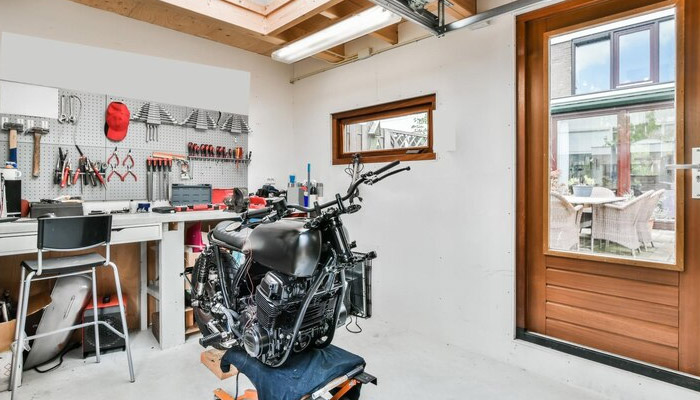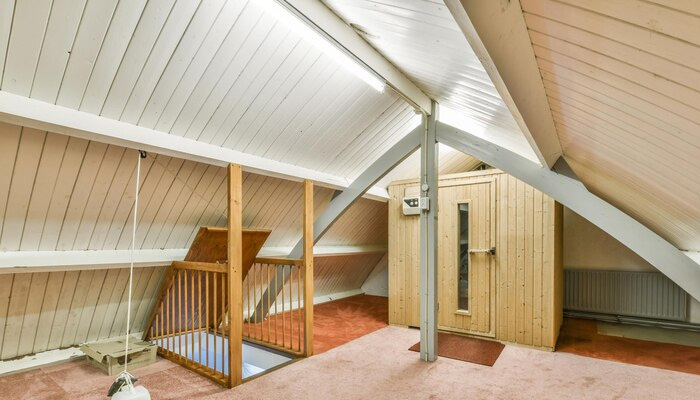Home expansion is a fantastic way to elevate your living space, improve functionality, and add significant value to your property. Whether you dream of a cozy sunroom, a second-floor retreat, or an expanded kitchen for family gatherings, the possibilities are endless. You will learn about 12 detailed ideas on creative ways to add on a room to your house while minimizing your budget.
Learn more: How Neglected Belongings Can Haunt Your Home
Additionally, we’ll explore practical tips on how to build an addition and how to add square footage to your house efficiently. This guide will help you choose what fits your needs best, particularly for a small house addition, and decide whether to hire a contractor or tackle the project as a DIY venture.
Maximize Your Space—Get Started with Our Storage Services Today!
12 Most Popular Home Addition Ideas to Enhance Your Space
1. Living Room Bump-Out

- Best For: Families who need additional seating or a more spacious living space.
- Description: A bump-out is an extension of a room by a few feet, making it more spacious and inviting to live in. It is a great solution for small homes seeking to maximize space without building an entirely new room.
- Features: Add large windows or sliding glass doors to let in natural light and create a seamless connection with the outdoors.
- Tip: Pair it with built-in seating or storage to make the most of your new space.
Learn more: 10 Tips for Living in Small Spaces with Kids and Dogs
2. Back House Room Additions

- Best For: Homeowners needing extra bedrooms, a playroom, room addition for small homes, or a private guest suite.
- Description: Adding another room to the back of the house will give more privacy and functionality. This can be very versatile and suited for use as an office, a gym, or as a rental space.
- Features: An in-room en-suite bathroom is added for added convenience.
- Tip: Use eco-friendly materials and energy-efficient windows to conserve energy.
3. Home Office or Study

- Best For: Remote workers or students needing a quiet workspace.
- Description: A home office does not necessarily have to occupy much space in the house. The small room or closet can be turned into a study area or even a tiny extension can be added for inspiration and functionality.
- Features: Essential features include built-in shelves, good lighting, and ergonomic furniture.
- Tip: Use soundproofing materials to reduce distractions.
4. Sunroom or Conservatory

- Best For: Homeowners who love soaking in natural light or enjoying the outdoors year-round.
- Description: A sunroom with floor-to-ceiling glass walls provides a serene escape for reading, dining, or even gardening indoors.
- Features: Consider installing retractable blinds or UV-protective glass to keep the space comfortable in all seasons.
- Tip: Decorate with potted plants and comfy furniture for a welcoming vibe.
5. Garage Conversion

- Best For: Those looking for budget-friendly means to add living square footage.
- Description: Convert your garage into a gym, art studio, or guest room. With very little construction, a garage conversion can be highly versatile.
- Features: All such buildings need proper insulation, heating, and cooling systems.
- Tip: Consider a foldable bed or modular furniture for ultimate functionality.
6. Kitchen Expansion

- Best For: Cooking enthusiasts and families that entertain often.
- Description: Adding a breakfast nook, larger countertops, or even a walk-in pantry to the kitchen is all part of an extension. This addition goes a long way in enhancing functionality and visual appeal.
- Features: Modern appliances, an island, or a bar counter can be added for versatility.
- Tip: Use contrasting materials like wood and stainless steel to have a clean yet cozy feel.
7. Second-Floor Addition

- Best For: Growing families or homeowners with limited outdoor space.
- Description: Installing another floor is a major exercise, effectively doubling the living area, and can contain several bedrooms and toilets or even a lounge.
- Features: Reinforce your foundation and plan layout. This is to help enhance space without losing much-needed privacy.
- Tip: Consult a structural engineer to ensure the existing structure can handle the additional load.
8. In-Law Suite
-
- Best For: Multigenerational families or long-term guests.
- Description: An in-law suite is essentially a small, self-contained unit within your home or as a separate structure. It typically includes a bedroom, bathroom, and kitchenette.
- Features: Accessible design features such as wider doorways and grab bars enhance usability for elderly occupants.
- Tip: Site the suite for privacy, for example, in a basement or detached building.
Learn more: The Beginner’s Guide To Barndominium Homes
9. Basement Remodel

- Best For: Someone looking to add extra space without moving outward.
- Description: A basement remodel can become an in-home theater, game room, or extra bedroom. The underground space allows for creative layouts and themes.
- Features: Proper waterproofing, lighting, and ventilation are key.
- Tip: Include soundproofing for entertainment-focused basements.
10. Expanding the Bathroom

- Best For: Adding luxury and comfort to small homes.
- Description: Expanding your bathroom gives you room for spa-like features like a soaking tub or double vanity.
- Features: Choose durable, water-resistant materials and energy-efficient fixtures.
- Tip: Add a skylight for natural lighting and ventilation.
11. Home Gym Addition

- Best For: Fitness enthusiasts seeking a private workout space.
- Description: A home gym addition can be as simple as repurposing a room or as complex as building a separate extension.
- Features: Include proper flooring, mirrors, and storage for equipment.
- Tip: Install a sound system to create an immersive workout environment.
Learn more: 6 Tips To Help You Settle Into Your New Home Quickly
12. Outdoor Living Space

- Best For: Families who love entertaining or relaxing outdoors.
- Description: Create a deck, patio, or outdoor kitchen with comfortable seating, a grill, and even a fire pit. This addition is ideal for hosting gatherings or enjoying nature.
- Features: Weather-resistant materials and retractable awnings enhance durability and usability.
- Tip: Use string lights to add ambiance during evening gatherings.
How to Choose a Home Addition
Here are some questions to consider when choosing the right extension to your house:
- Will the Number of Residents Change?
Consider future family needs, such as children or elderly parents moving in.
- Will Your Financial Situation Change?
Budget realistically, factoring in construction costs and future maintenance expenses.
- Will the Home Addition Add to the Home Value?
Prioritize additions with high ROI, such as kitchens, bathrooms, or second floors.
How Much Does It Cost for an Expanding House?
- Living Room Bump-Out: $10,000 to $30,000
- Back House Room Additions: $20,000 to $75,000
- Garage Conversions: $10,000 to $25,000
- Second-Floor Addition: Starting at $100,000
- Outdoor Living Space: $5,000 to $15,000
Contractor vs. DIY
- Complex Projects (e.g., Second-Floor Addition): Contractors are better for large, structural projects requiring expertise.
- Simple Upgrades (such as a living room bump out ideas): DIY room addition saves money for smaller, more manageable jobs.
- Money Savings: Contractors may charge a premium but guarantee high-quality work, and DIY requires equipment and labor.
- Timeline: A contractor will finish the job much faster, and with DIY time consumed, flexibility is also possible.
- Skill Level: DIY only if you’re confident in your abilities; otherwise, engage a professional.
Maximize Your Space—Get Started with Our Storage Services Today!
Conclusion
From small bump-outs to large-scale second-floor additions, there are so many ways to add more space by room addition ideas and functionality to your home. Each addition should meet your needs, budget, and long-term goals. Whichever route you take, hiring a contractor or taking on the project yourself, planning will make sure that your new addition is a valuable and enjoyable part of your home.
FAQs For Most Popular Home Addition Ideas To Enhance Your Space
1. What Are the Most Cost-Effective Options for Adding a Room to a Home?
The most budget-friendly ways to add a room include converting existing spaces such as a basement, attic, or garage. Alternatively, small bump-outs or prefab modular additions can be economical options, as they typically require fewer structural changes and less labor.
2. Is It More Affordable to Add to Your Home or Build Up?
Adding outward (horizontally) is often cheaper than building upward, as a second-floor addition requires reinforcing the existing structure to support the added weight. However, building up may be more cost-effective in properties with limited land.
3. Which Home Additions Add the Most Value?
Kitchen expansions, bathroom additions, and in-law suites tend to add the most value to a home. These spaces are highly desirable for buyers, offering functionality and luxury that can significantly increase the property’s resale price.
4. Is It Better to Build a Home Addition or Move to a Bigger House?
This depends on factors such as your budget, emotional attachment to your current home, and the local real estate market. A home addition may be more cost-effective if you love your neighborhood and property, while moving may be better if your needs far exceed the capacity of your current space.
5. What Are the Maintenance Considerations for a New Home Addition?
Post-construction maintenance includes ensuring proper insulation, sealing any gaps to prevent drafts, and periodically checking for structural settling. Maintaining new HVAC or plumbing systems and keeping up with exterior painting or weatherproofing are also essential to prolong the life of your addition.








